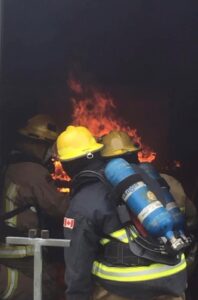Regularly testing carbon monoxide alarms saves lives

By Rick Garrick
FORT WILLIAM — Fort William fire prevention officer William Solomon recently stressed the importance of having working carbon monoxide alarms in the home on the community’s Facebook page.
“In my home, I have one on each level — I have one close to my furnace and I have one upstairs,” Solomon says. “Carbon monoxide is odourless, colourless and you don’t know if it’s affecting you until it’s too late. It replaces the oxygen in your red blood cells. You start to get flu-like symptoms and once it gets to the point where it starts to affect you, you could lose consciousness.”
Solomon began his Facebook posting by asking: “Are there heroes in your home?”
“You as an individual in your home could save everyone in your home just by regularly testing your CO (carbon monoxide) alarms, making sure your backup batteries are good because in the instance of a power outage, your battery in your CO detector will keep it going and make sure there is nothing leaking into your home,” Solomon says.
Solomon says the carbon monoxide could come from a variety of gas or wood-fired heating and cooking units in the home.
“The most common is the gas furnace and gas stove,” Solomon says, noting that fireplaces, gas dryers, water heaters and portable fuel heaters can also release carbon monoxide into the home. “If you have a wood stove in your home, that could also release carbon monoxide.”
Solomon says he does regular programming in the community to test carbon monoxide alarms, smoke alarms and fire extinguishers in homes.
“If they are out of date or they just simply need to be replaced due to damage, I have a program that I replace them for our community [citizens],” Solomon says.
“Right now I am focusing on Elders and the vulnerable sectors.”
Solomon says carbon monoxide detectors should be replaced every three-to-five years.
“They do tend to get a little bit dirty if they are not regularly maintained,” Solomon says.
Solomon says any equipment that is not dated and was not installed by the home occupant should be replaced.
“If you didn’t install it yourself, it’s good to just switch it out so you know exactly when your equipment’s been installed,” Solomon says. “It just kind of adds that extra level of protection.”
Solomon says he has seen outdated equipment in homes since he began his role as fire prevention officer in 2019.
“When I go in for a home visit, the first thing I’ll do before I even look at the date on the unit is I’ll test it,” Solomon says. “Testing your smoke alarms is the easiest thing you can do — there’s a big button right in the middle, you push it once and it runs the test for you.”
Solomon says the alarms he currently installs will chirp and then say aloud: “Fire” or “Carbon monoxide, get out.”
“I’m getting into the homes one by one and making sure our community [citizens] are safe,” Solomon says. “They hired me mid-year in 2019 and I’ve been working towards getting every house in our community safe from smoke, fire, carbon monoxide, fire hazards in the home [and] fire hazards outside of the home like your furnace outlet and your dryer outlet, making sure that they’re not blocked in the winter and there is no obstruction in them or around them. If that gets plugged up or your vent doesn’t open up right, that could pump [carbon monoxide] right back into your home.”
Solomon says he also checks to make sure people have two exits from their home and their windows are not nailed shut.


